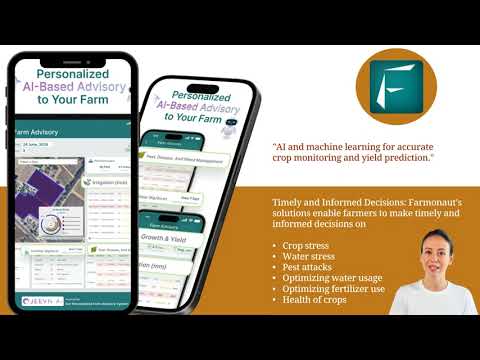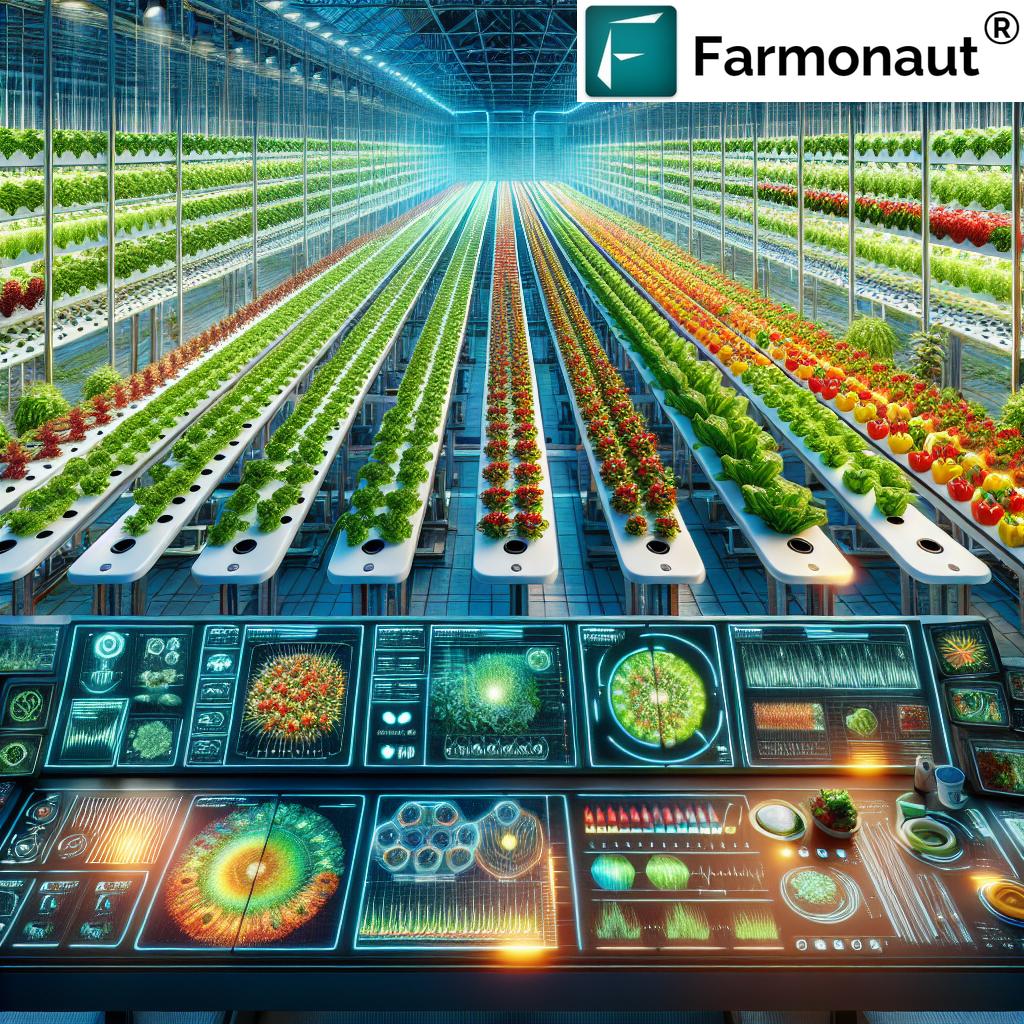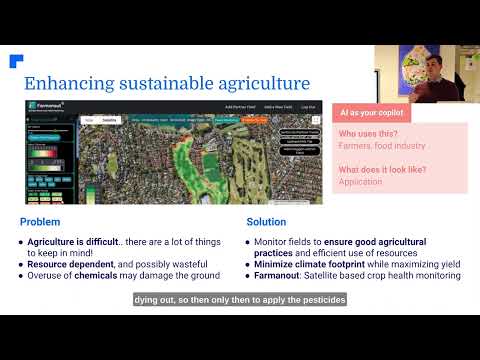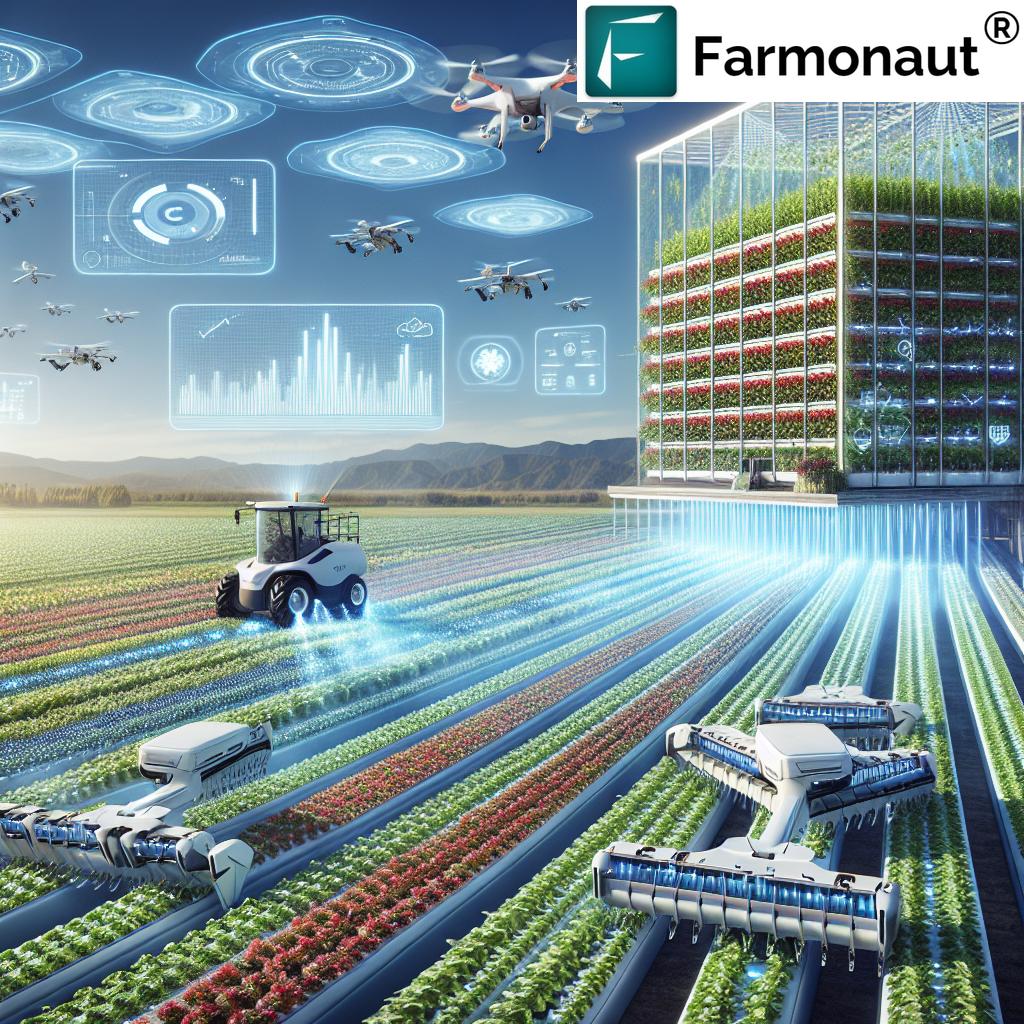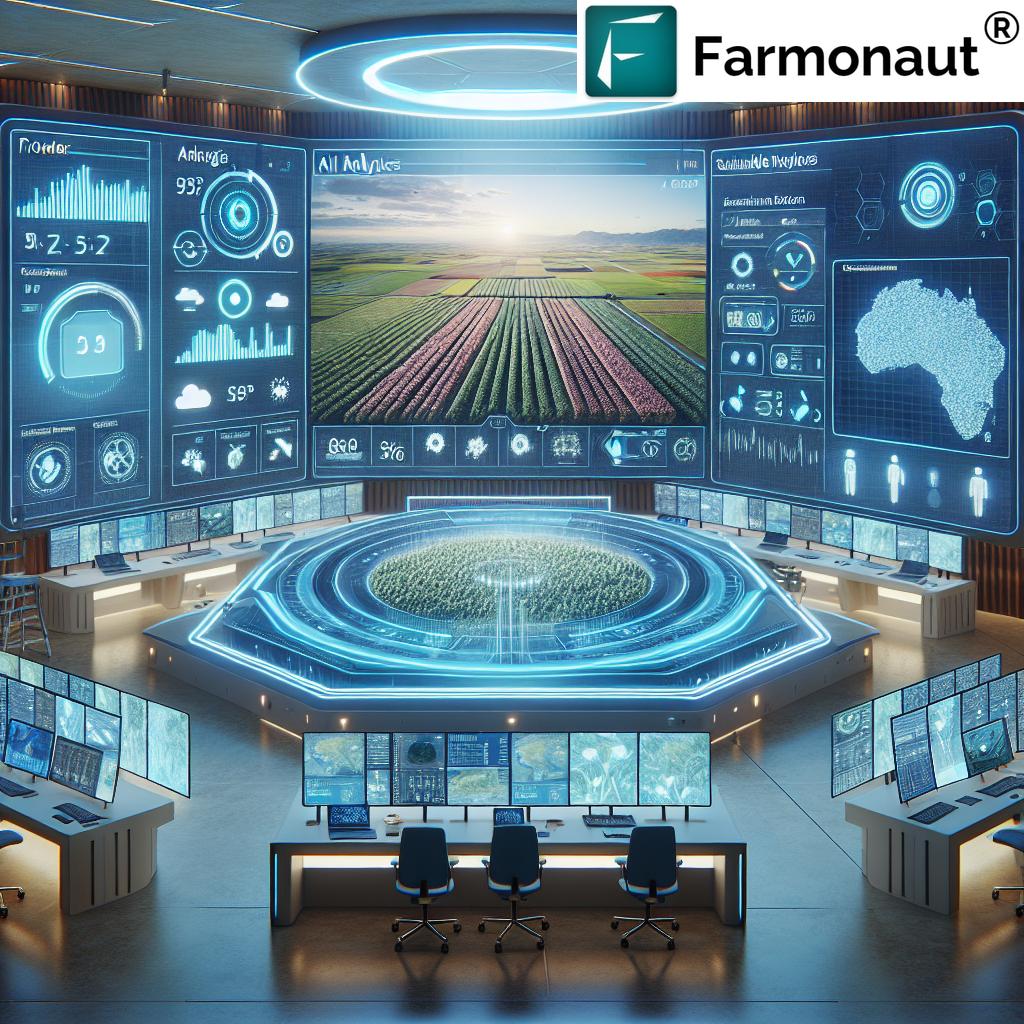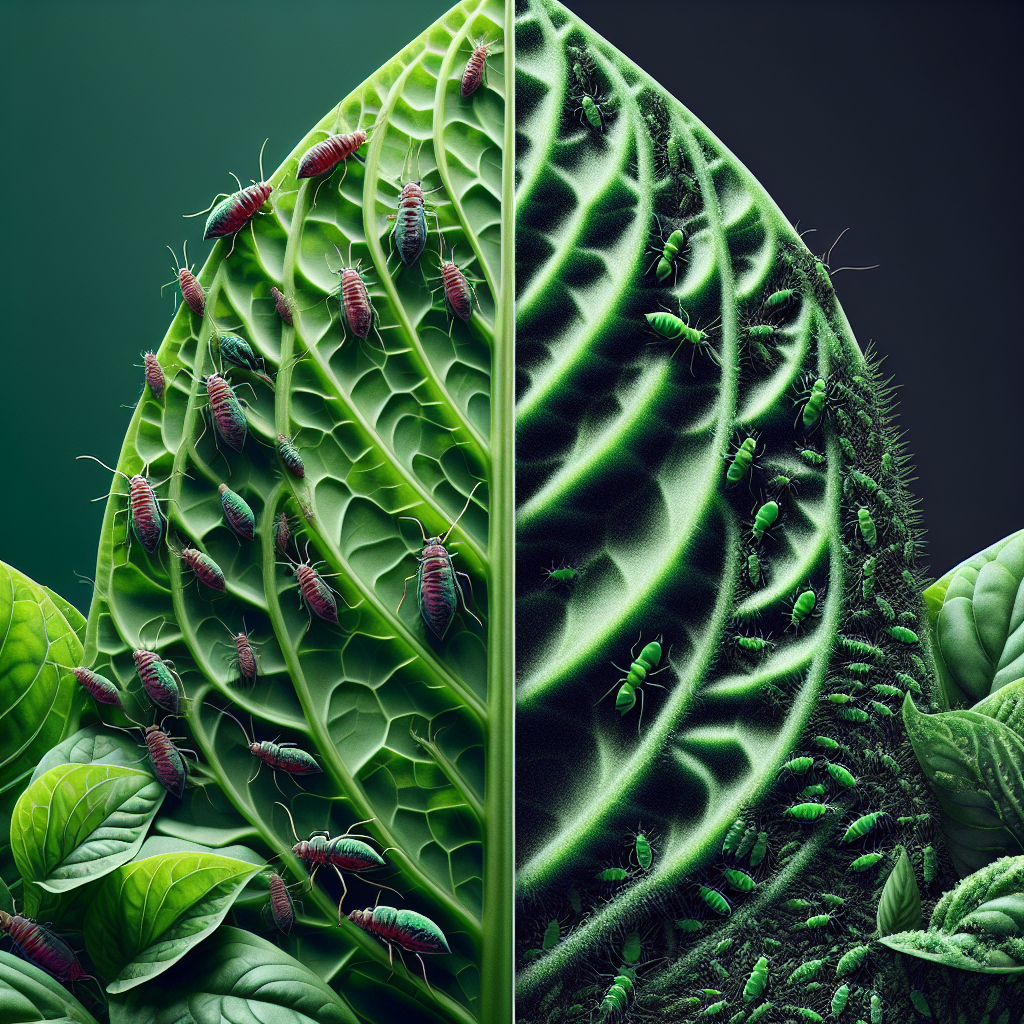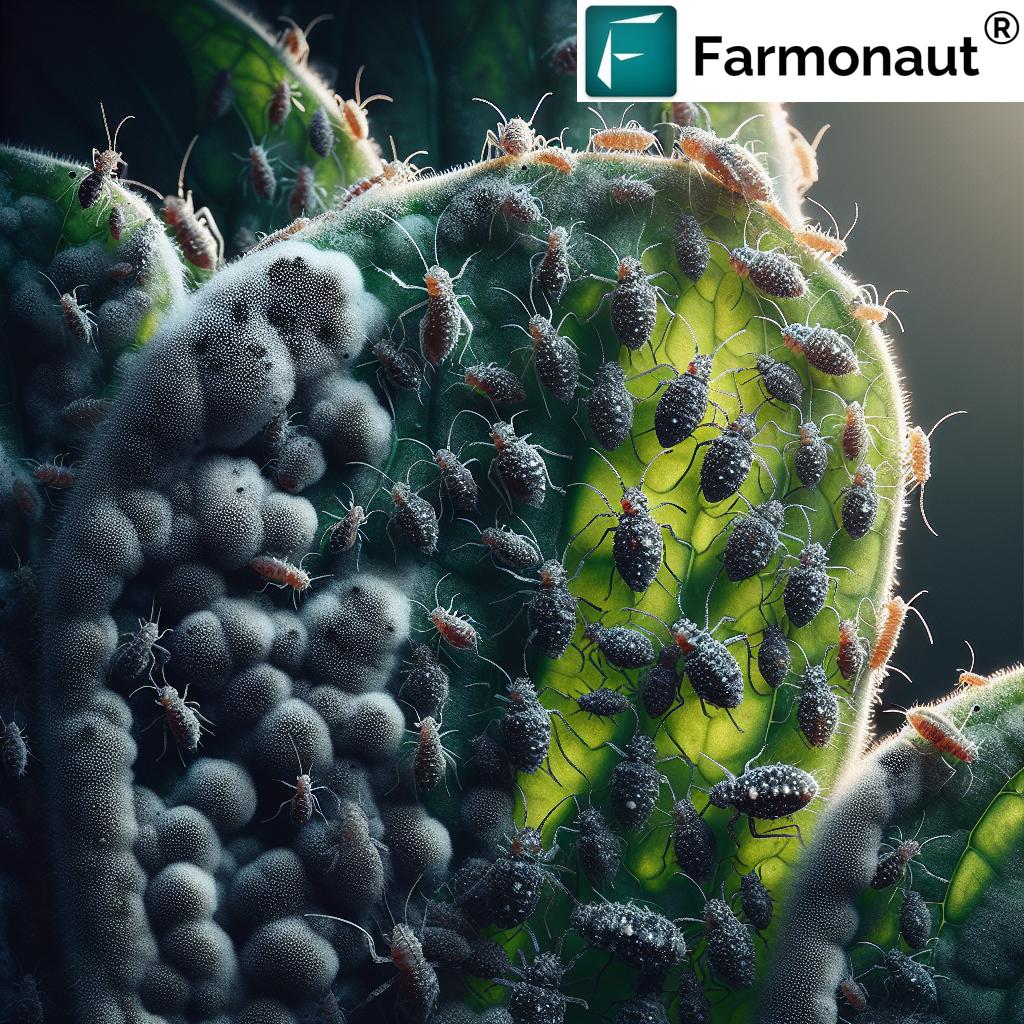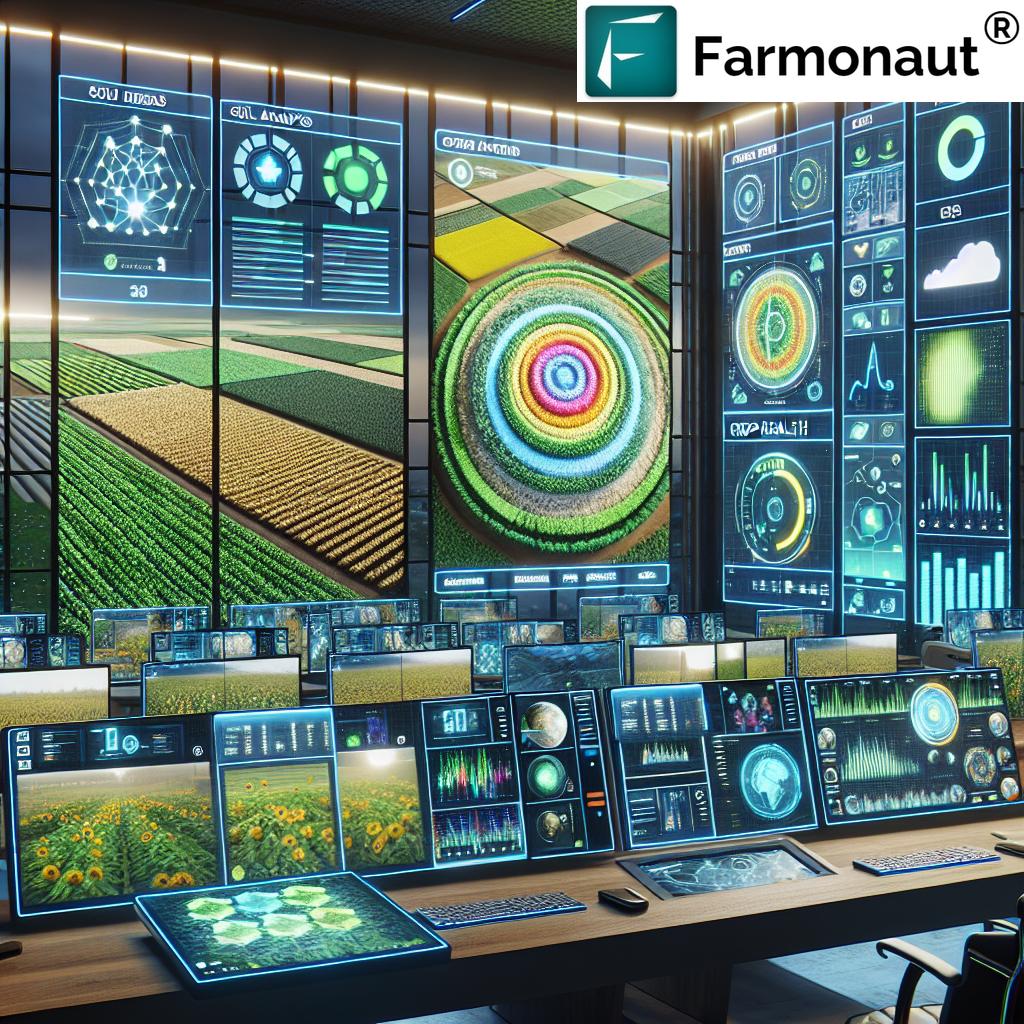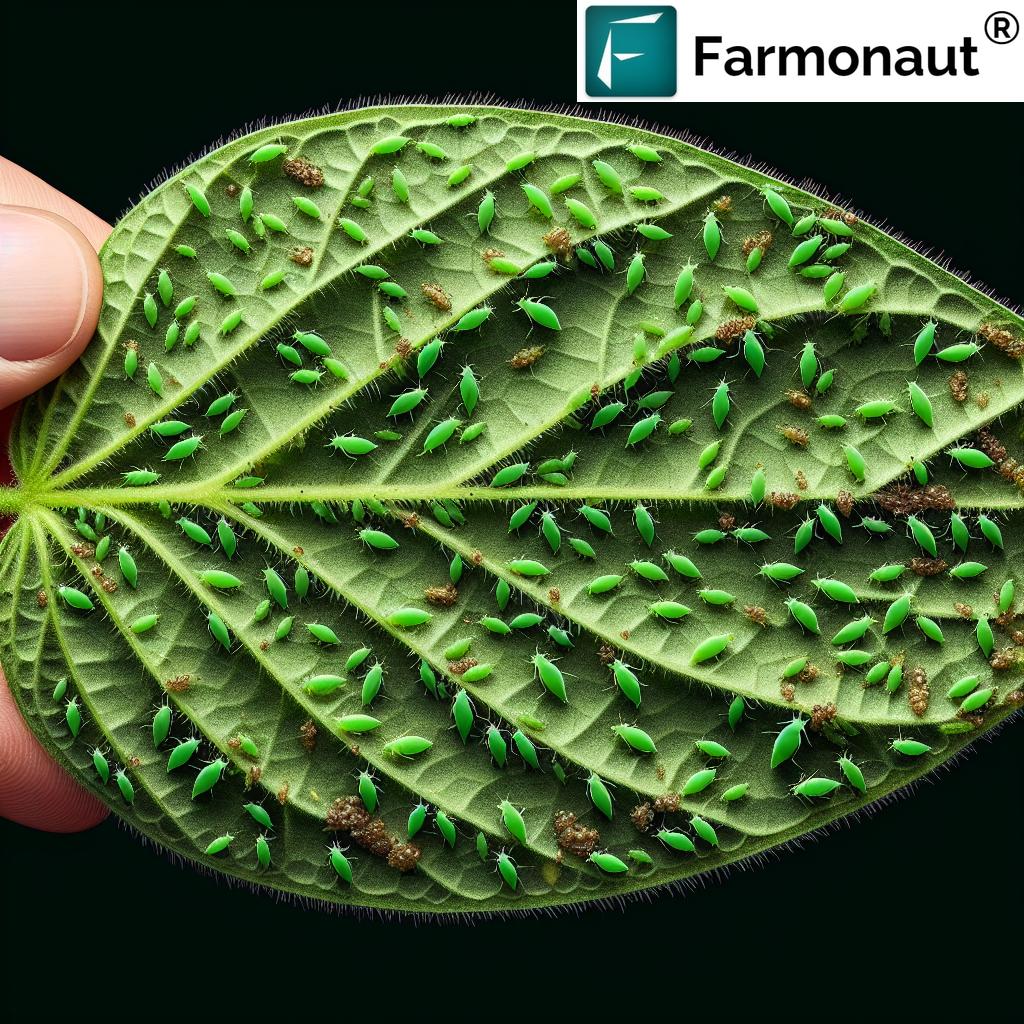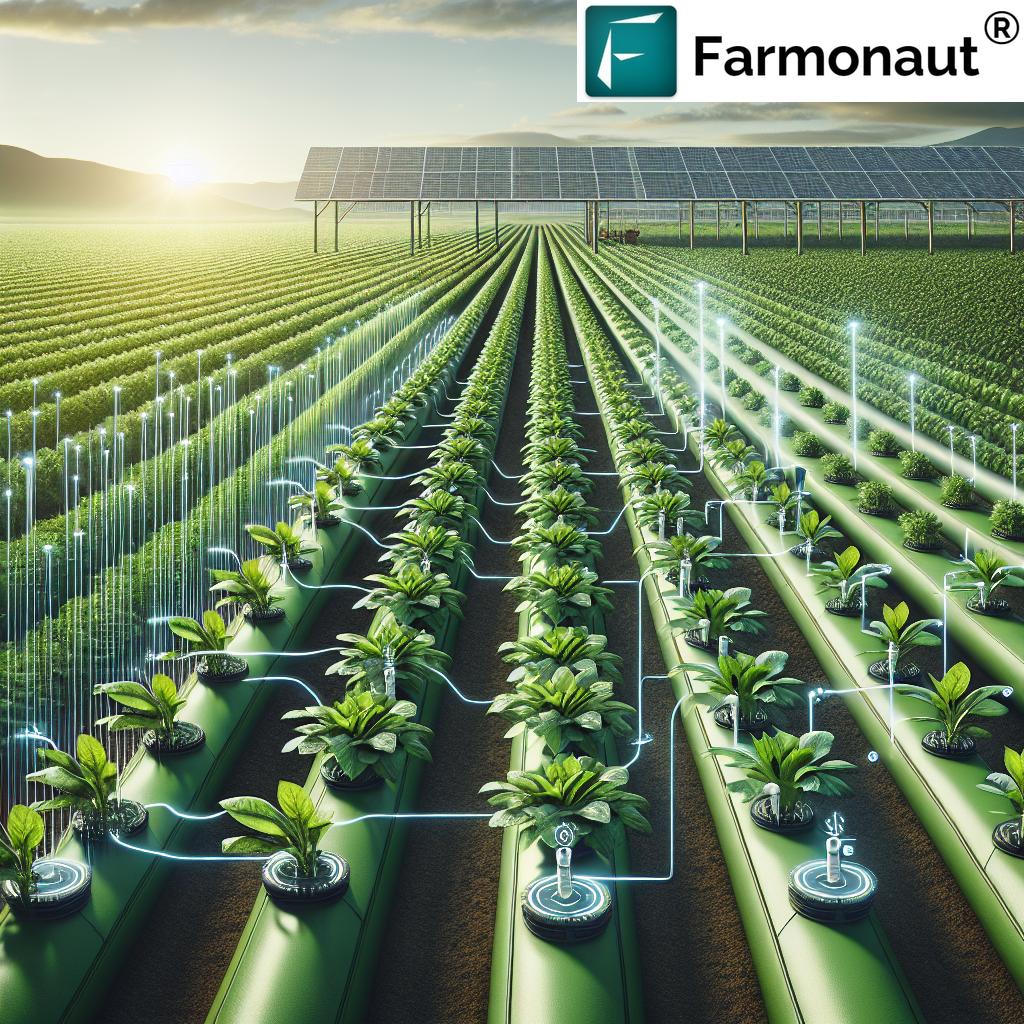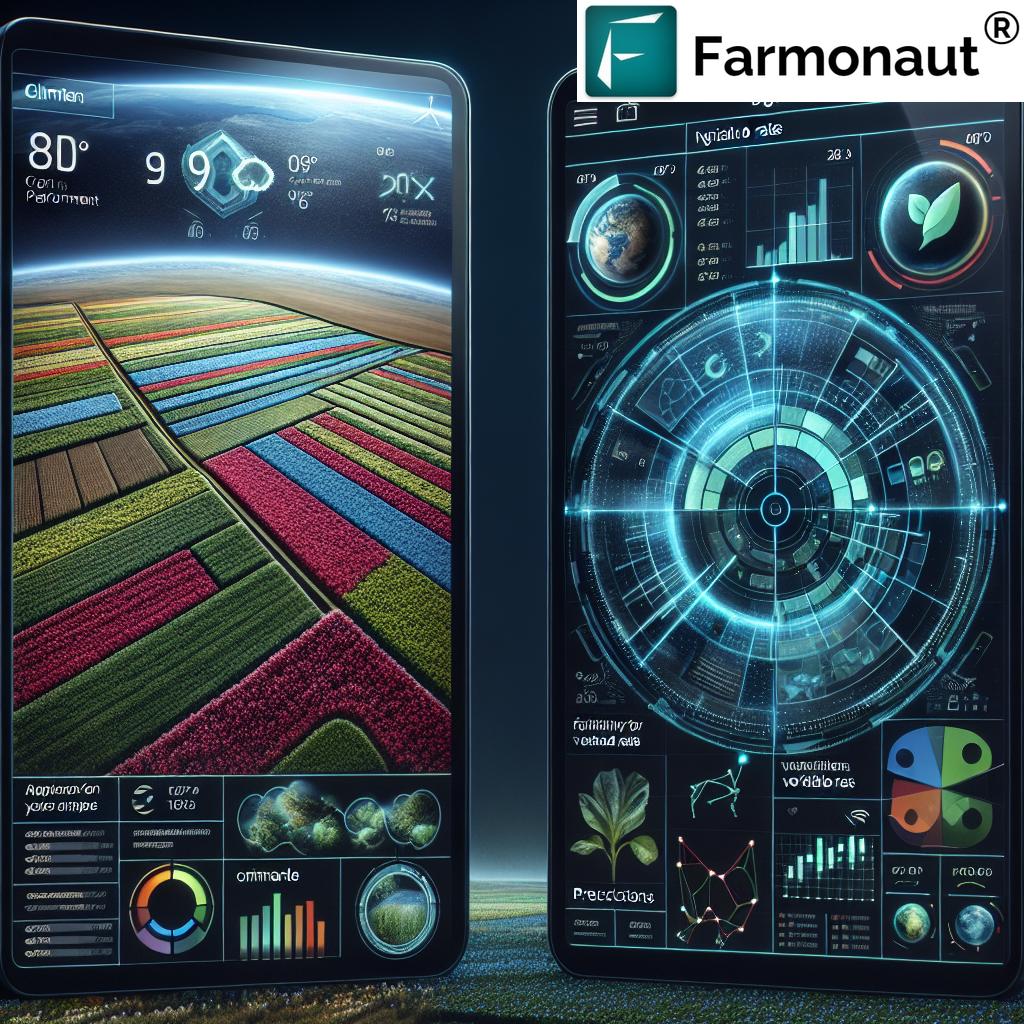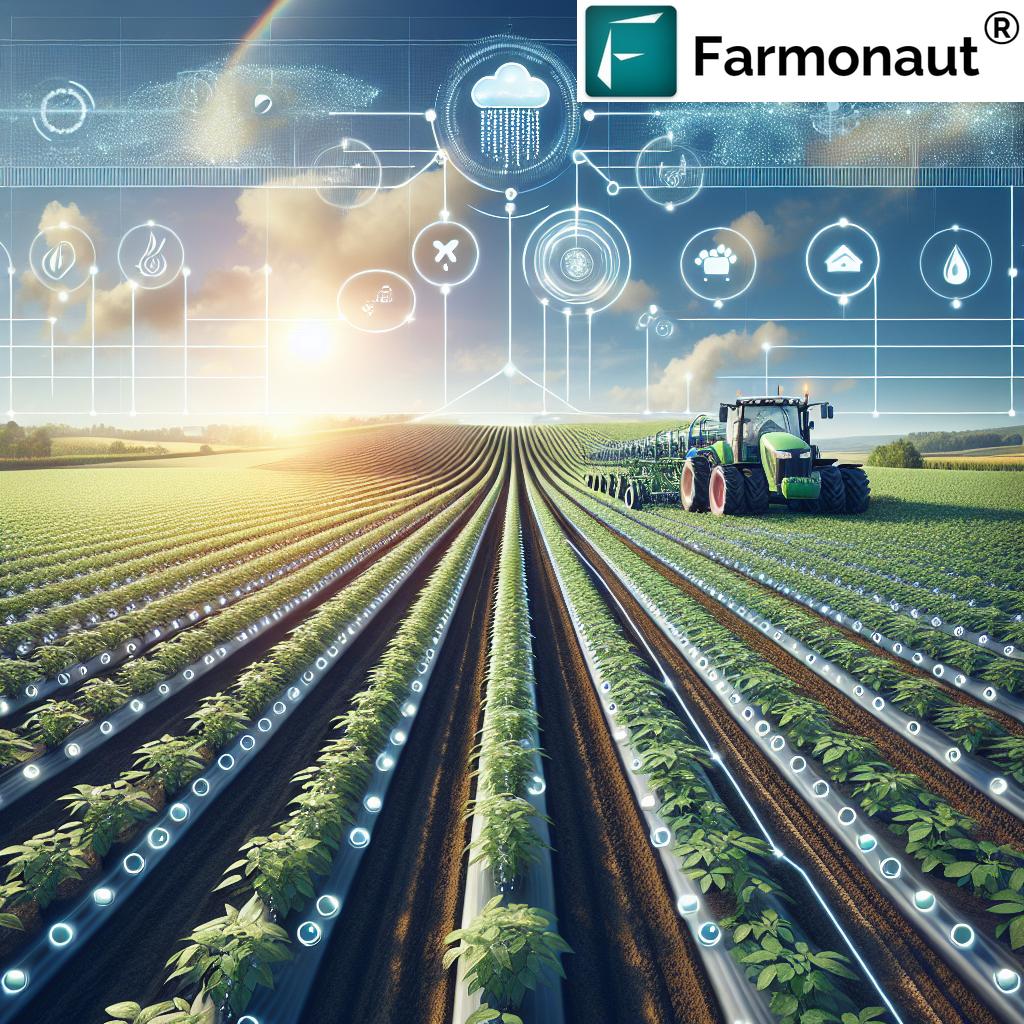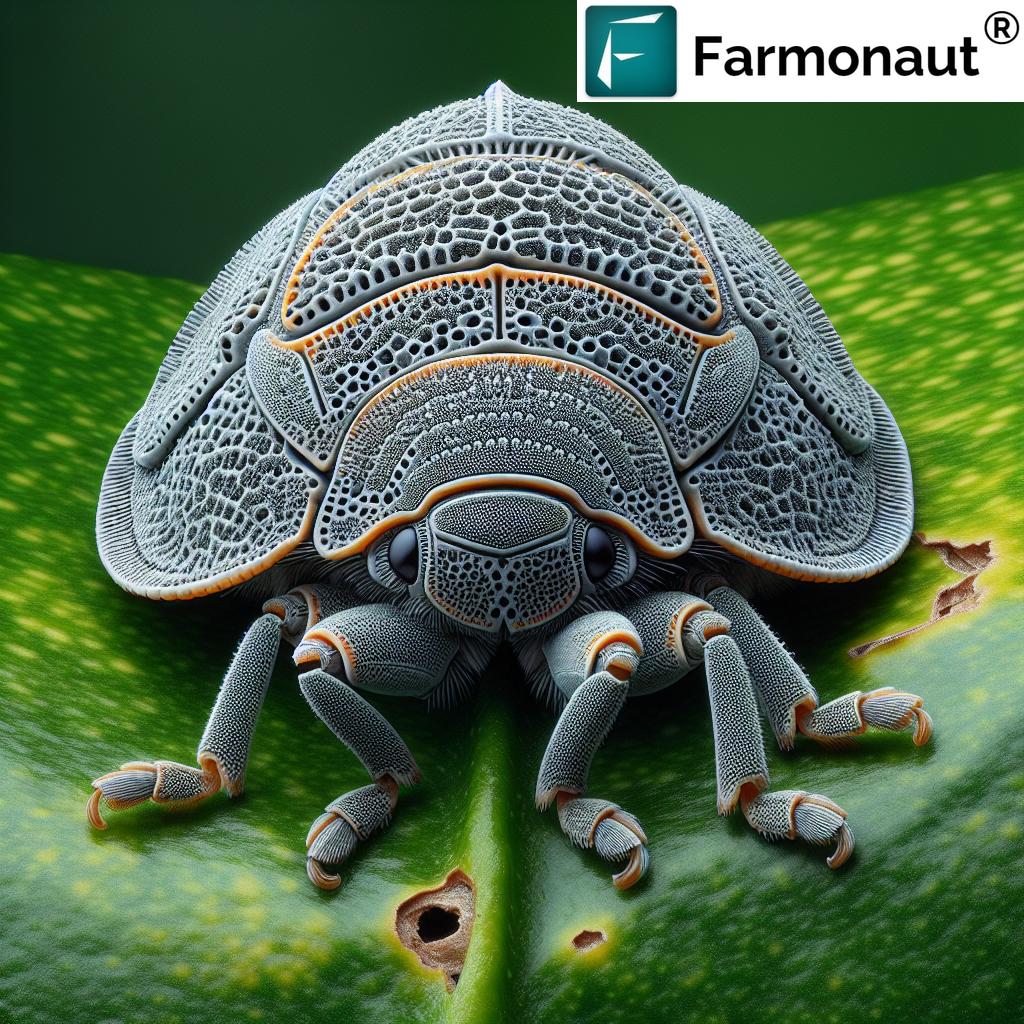Table of Contents
- Introduction
- Historical Evolution of Agricultural Technologies
- 1. Precision Agriculture
- 2. Unmanned Aerial Vehicles (UAVs) & Drone Technology
- 3. Robotics and Automation
- 4. Artificial Intelligence and Machine Learning in Farming
- 5. Nanotechnology & Nanosensors
- 6. Controlled-Environment Agriculture (CEA)
- 7. Agroforestry & Farmer-Managed Natural Regeneration
- Bonus: Blockchain and Food Traceability
- Comparative Technology Impact Table
- Challenges and Future Prospects in Agricultural Innovation
- FAQ: Agricultural Technologies & Smart Farming
- Farmonaut Precision Agriculture Subscription Plans
“Precision agriculture can increase crop yields by up to 20% using data-driven decision-making tools.”
7 Agricultural Technologies Changing Farming Forever
In recent years, we have witnessed a revolution in agricultural technology, with innovations like precision agriculture, drone technology in agriculture, and artificial intelligence in farming that are transforming how we farm. These advancements are not just about boosting productivity—they are fundamentally changing the sustainability, efficiency, and resilience of modern agriculture, forestry, and food systems.
As farmers, agribusinesses, and policymakers, it is our responsibility to leverage these cutting-edge tools to optimize our soil health monitoring, manage resources, lower labor costs, and guarantee food safety for a rapidly growing global population. And platforms like Farmonaut—a leader in affordable satellite-based precision agriculture—make it possible for us to integrate smart farming solutions at every scale. In this guide, we will explore the technologies changing farming forever, examine their evolution, and discuss how we can use them to ensure a productive and sustainable future.
Historical Evolution of Agricultural Technologies
Our journey through agricultural innovation began with manual labor and simple hand tools. The Industrial Revolution redefined agriculture when machinery such as the plow and the combine harvester allowed us to mechanize planting, harvesting, and processing, making farm management more efficient and scalable. These mechanized processes set the stage for the 20th century’s Green Revolution, which introduced high-yielding crop varieties, synthetic fertilizers, and chemical pesticides—boosting production but also raising sustainability concerns.
Today, the digital transformation of agriculture is led by GNSS and GPS technologies, data-driven practices, AI, blockchain food traceability, and advanced sensor systems. The convergence of these innovations is ushering in an era where we optimize every variable of crop production while prioritizing the sustainability of our food and forestry systems.
1. Precision Agriculture: Optimizing Farm Management with Technology
Precision agriculture, also known as smart farming, is about using the power of data, sensors, satellites, and AI to make farming more efficient, sustainable, and profitable. Instead of treating entire fields uniformly, we use GPS and GNSS solutions to map and manage the spatial variability in crop growth, soil moisture, nutrient levels, and yield. This enables variable rate applications (VRT) of resources such as water, fertilizers, and pesticides, thus minimizing waste and environmental impact while maximizing yields.
- Key Features: Real-time crop and soil health monitoring, targeted irrigation, optimized input distribution.
- Benefits: Lower input costs, higher productivity, reduced environmental footprint.
- Farmonaut’s Contribution: By combining satellite-based crop health data with AI-driven crop management advice (such as with the Jeevn AI Advisory System), Farmonaut empowers us to monitor our farm fields remotely, track crop growth, and make timely, precise decisions for sustainable agriculture practices.
Want to start leveraging satellite-driven precision agriculture on your own farm? Try Farmonaut’s app for instant access to precision analytics, tailored crop advisory, and blockchain-based traceability!
How Precision Agriculture Improves Crop Productivity and Farm Efficiency
- Site-specific management: Variable rate technology (VRT) systems allow us to apply resources exactly where and when needed, optimizing for yield and minimizing costs.
- Remote monitoring: Satellite and drone imagery makes it possible to monitor soil moisture, nutrient levels, and even detect pests or diseases before they become widespread.
- Data management: Precision agriculture relies on the continuous collection and analysis of big data from sensors, satellites, and weather stations—improving every aspect of farm management.
“AI-powered systems in agriculture can reduce pesticide use by as much as 30% through targeted application.”
2. Unmanned Aerial Vehicles (UAVs) & Drone Technology in Agriculture
Unmanned Aerial Vehicles (UAVs), commonly known as drones, are among the most transformative agricultural technologies for the modern farm. Drones equipped with multispectral cameras and high-resolution sensors provide unprecedented monitoring capabilities—from mapping seedling density to detecting weeds, pests, and disease pressure across vast fields.
- Crop health monitoring: UAVs collect NDVI and multispectral images, making it easy to spot stress areas or nutrient deficiencies in crops long before they’re visible to the naked eye.
- Variable rate spraying: With drone technology in agriculture, we can apply fertilizers and pesticides only where needed, drastically reducing chemical use and contamination risk.
- Efficient scouting: Rapid flyovers replace time-consuming manual scouting and reduce labor costs.
Curious about the environmental and productivity gains of precision UAV monitoring? See how Farmonaut’s platform can integrate drone and satellite data for comprehensive field management.
Applications & Benefits of Drone Technology in Agriculture
- Monitoring spatial variability: Drones help us map and analyze field zones, improving site-specific crop management.
- Yield estimation and plant counting: UAV-generated data supports better decision-making for harvest planning and market logistics.
- Protecting environmental resources: Reduced chemical use and run-off preserves soil and water quality.
3. Robotics and Automation: Reducing Labor & Boosting Sustainability
Robotics and automation are redefining how we execute manual tasks on the farm. From autonomous tractors guided by GPS to intelligent weeding and harvesting robots, these systems tackle repetitive, labor-intensive operations with superior efficiency and precision.
- Autonomous tractors: GPS and sensor-equipped vehicles accurately carry out plowing, planting, and spraying, freeing up time and reducing human error.
- Robotic weed control: Advanced robots use AI and machine vision to identify and remove weeds, lowering our reliance on chemical herbicides and supporting sustainable agriculture practices.
- Harvest robots: Robotic pickers automate the delicate process of harvesting fruits and vegetables, improving consistency and reducing crop losses.
Learn how farm machinery can be managed and optimized efficiently throughout the season. Farmonaut’s Fleet Management tools empower you to track vehicles, optimize routes, and minimize operational costs—all critical for scaling up smart farming solutions.
4. Artificial Intelligence and Machine Learning in Farming
Artificial intelligence (AI) and machine learning have changed the way we use data to monitor, predict, and optimize agricultural operations. By harnessing big data from sensors, drones, and satellite imagery, AI allows us to:
- Detect and diagnose crop health issues early: AI-driven image analysis can spot diseases, nutrient deficiencies, or pest infestations before widespread damage occurs.
- Predict yields with high accuracy: Machine learning models analyze historical data, weather variables, and soil conditions to estimate future yields—helping us plan better and manage market risks.
- Automate decision-making: AI-based advisory systems, like Farmonaut’s Jeevn AI, deliver personalized recommendations to optimize resource use, timing, and crop management tasks for efficiency and sustainability.
Interested in smarter, data-driven crop management? Explore how Farmonaut’s Carbon Footprinting tools help you reduce your farm’s environmental impact while maximizing profitability and productivity.
Why Artificial Intelligence is Transforming Farm Management
- Integrated data streams: AI combines data from satellites, drones, field sensors, and weather models for a holistic view of crop health and farm operations.
- Savings and productivity: Automated detection and predictive maintenance improve yields, reduce waste, and lower production costs.
- Sustainability benefits: By enabling precise interventions, AI helps us use fewer inputs and minimize our environmental footprint—a major goal of sustainable agriculture practices.
5. Nanotechnology & Nanosensors: Transforming Soil Health Monitoring
Nanotechnology brings powerful new tools to soil health monitoring and precision input management. Nanosensors embedded in fields or crops can track moisture, detect pathogens, and monitor nutrient levels (such as nitrate and phosphate) in real-time. This leads to more targeted application of water and fertilizers, reducing waste and optimizing plant growth.
- Types of nanosensors: Graphene-based sensors for nitrate, zinc oxide for nitrogen, and advanced microfluidic chips for rapid disease detection.
- Benefits: Improve soil structure and fertility, enable early detection of disease outbreaks, and facilitate more sustainable, data-driven farming practices.
- Resource optimization: With nanotechnology, we are able to maximize resource efficiency with minimal environmental impact.
For large farm or plantation managers, Farmonaut’s Large Scale Farm Management Solution offers robust monitoring, reporting, and multi-field data analytics—ideal for implementing advanced nanotechnology strategies on extensive agricultural operations.
6. Controlled-Environment Agriculture (CEA): Maximizing Production & Resilience
Controlled-Environment Agriculture (CEA) is reshaping the way we manage food production in urban and rural communities. By growing crops in greenhouses, vertical farms, or fully indoor setups, we precisely regulate variables like temperature, humidity, light, and nutrients—enabling year-round production and minimizing exposure to adverse weather or pests.
- Hydroponics, Aeroponics, and Aquaponics: These innovative methods optimize water and nutrient use, reducing waste while boosting yields and intensifying land use in space-constrained environments.
- Urban food security: Vertical farming makes it possible to grow food closer to consumers, lowering transportation costs and emissions.
- Sustainability: CEA systems deliver very high productivity with minimal environmental impact, making them essential for future urban and peri-urban farming.
Interested in the future of vertical, climate-resilient farming? Discover Farmonaut’s Crop Plantation & Forest Advisory—offering data-driven recommendations for both CEA and agroforestry systems.
7. Agroforestry & Farmer-Managed Natural Regeneration (FMNR)
Agroforestry integrates trees, crops, and/or livestock on the same land, combining the benefits of forestry technologies with modern farm practices. This approach delivers:
- Increased biodiversity: Promotes a balance of species that support natural pest control and soil health.
- Soil restoration: Tree roots stabilize soil, reduce erosion, and help rebuild organic matter.
- Carbon sequestration: Trees in agroforestry systems capture and store carbon, supporting climate change mitigation efforts.
- Diversified production: Provides food, timber, fruit, nuts, and fuel—all while maintaining productivity and resilience.
Farmer-Managed Natural Regeneration (FMNR) is a cost-effective technique where existing root systems or seedbanks are carefully managed to restore degraded land and agricultural fields. This process rapidly increases tree cover, enhances soil fertility, and supports sustainable rural livelihoods.
Ready to implement agroforestry and FMNR in your farming system? Take advantage of Farmonaut’s Advisory Resources for remote monitoring, soil analysis, and location-specific environmentally-smart recommendations.
Bonus: Blockchain and Food Traceability—Ensuring Transparency from Farm to Fork
Blockchain food traceability solutions are building trust and transparency in agriculture supply chains. By securely recording every step of a product’s journey—seed planting, fertilizer application, harvesting, processing, storage, transport, and retail—blockchain creates a tamper-proof record that guarantees food provenance and integrity.
- Advantages: Reduces food fraud, increases accountability, protects consumers, and makes certifications (such as organic or fair trade) verifiable with a click.
- For producers: It also helps build brand reputation, access premium markets, and comply with evolving food safety regulations globally.
Interested in securing your supply chain or ensuring your products’ journey is transparent and verifiable? Explore Farmonaut’s Blockchain-Based Product Traceability solution for seamless farm-to-fork tracking and consumer trust-building.
Comparative Technology Impact Table: Precision Agriculture, AI, and Drone Innovation
| Technology Name | Primary Function | Estimated Yield Improvement (%) | Estimated Cost Reduction (%) | Adoption Rate (Estimated %) | Sustainability Impact |
|---|---|---|---|---|---|
| Precision Agriculture | Optimize input use, monitor crop/soil health, VRT application | 10–20% | 15–25% | 30–40% | High |
| Drone Technology (UAVs) | Field mapping, multispectral crop monitoring, targeted spraying | 7–15% | 10–18% | 18–25% | Medium–High |
| Robotics & Automation | Automate planting, harvesting, weeding, spraying tasks | 8–14% | 20–30% | 10–20% | Medium |
| AI & Machine Learning | Predict yields, detect crop issues, automate advisory | 12–22% | 10–18% | 12–28% | High |
| Nanotechnology & Nanosensors | Soil nutrient monitoring, disease detection, resource optimization | 5–10% | 12–16% | 3–7% | High |
| CEA (Controlled-Environment Agriculture) | Climate-resilient crop production, high-density vertical farming | 30–50% | 8–16% | 2–8% | High |
| Agroforestry & FMNR | Integrate crops with trees for soil, biodiversity, & carbon | 15–30% | 10–15% | 8–18% | Very High |
| Blockchain Food Traceability | Transparent product tracking, fraud reduction | Indirect | Negligible–8% | 3–10% | High |
Table Notes: Data is based on public industry reports and estimates. Yield and cost improvements are contextual and depend on adoption scale, crop type, and local management practices. Sustainability ratings are evaluated on impact for resource optimization, environmental protection, and carbon reduction.
Challenges and Future Prospects in Agricultural Innovation
Key Challenges Facing Advanced Agricultural Technologies
- High initial investment: Some of these innovations, especially automation and CEA systems, can be costly to deploy at scale for smallholder farmers or in developing regions.
- Complexity & technical skills: Adoption often requires capacity building and training for effective implementation and troubleshooting.
- Infrastructure limitations: Connectivity, reliable electricity, and digital infrastructure gaps can limit adoption in remote areas.
- Policy & regulatory frameworks: Ensuring that data privacy, safety, and sustainability standards are met is an ongoing challenge as the technology evolves.
The Road Ahead: How We See the Future
- We expect continued integration of technologies—such as combining IoT sensors, AI, and satellite imagery for seamless, automated decision-making at every level of agriculture and forestry.
- Sustainability will become the core metric for innovation, with a shift towards regenerative, low-input production systems supported by real-time monitoring and traceability platforms.
- Accessible, affordable data platforms like Farmonaut will democratize precision agriculture worldwide, enabling growers of all scales to participate in the next green revolution.
-
Curious about advanced resource management, traceability, or satellite imagery for government, NGOs, or financial institutions?
Explore Farmonaut’s API for Integration or check out API Developer Documentation for seamless high-scale deployment.
FAQ: Agricultural Technologies & Smart Farming
Precision agriculture refers to the use of advanced technologies—such as GPS, remote sensing, and data analytics—to optimize resource use, improve soil health, manage crop variability, and increase yield and efficiency for each specific field area.
Q2. How do drones make agriculture more efficient?
Drones (UAVs) equipped with multispectral and thermal cameras help us monitor large farm areas by quickly mapping crop health, spotting pest or disease outbreaks, and guiding targeted spraying of fertilizers or pesticides, thereby saving time, money, and reducing environmental impact.
Q3. Can AI really help farmers make better decisions?
Yes. Artificial intelligence in farming leverages big data from satellites, sensors, and weather models to provide actionable insights, early warnings for disease, yield predictions, and personalized management recommendations for every stage of the crop cycle.
Q4. What are the environmental benefits of controlled-environment agriculture (CEA)?
CEA systems (greenhouses, vertical farms, etc.) optimize water, land, and nutrient use, minimize pesticide requirements, reduce transportation emissions, and enable reliable year-round food production even in extreme climates.
Q5. How does blockchain food traceability work for farm products?
Blockchain provides a secure, tamper-proof digital ledger that records every step of a product’s life—from farm to consumer. It ensures transparency, reduces fraud, supports certifications, and increases consumer confidence in product origin and quality.
Q6. I’ve heard of Farmonaut—how can I use the platform for my farm?
Farmonaut offers subscription-based access to advanced satellite-driven farm management, crop health monitoring, traceability, AI advisory, and carbon footprinting via web, Android, and iOS apps—as well as through an easy-to-integrate API for larger businesses or institutions.
Farmonaut Precision Agriculture Subscription Plans
Farmonaut operates on a highly flexible, scalable subscription model—allowing us to access affordable, real-time satellite data, crop monitoring, and smart advisory whether we’re managing a small family farm or a vast commercial plantation. Our service is designed for individual farmers, agribusinesses, institutional clients, and even government bodies.
-
Key Benefits of Farmonaut Subscriptions:
- Access precision agriculture insights without costly hardware investments.
- Track crop health, soil moisture, yield trends, and carbon footprint in real time.
- Boost productivity, optimize resources, and promote sustainable farm management.
- Leverage blockchain for food traceability and supply chain security.
- Seamlessly integrate via API for large-scale or enterprise deployments.
Conclusion
Transforming agriculture with precision technologies is not just a trend—it’s a necessity to sustainably feed the world. As we move away from manual, high-waste practices towards a more integrated, data-driven future, platforms like Farmonaut are at the forefront—making precision agriculture, AI, blockchain, and remote sensing accessible to all.
With these agricultural innovations now within reach, we have the opportunity and the responsibility to optimize every aspect of our farming, forestry, and food supply systems for productivity, sustainability, and resilience. The next revolution in agriculture is already here—let’s lead the change together!







